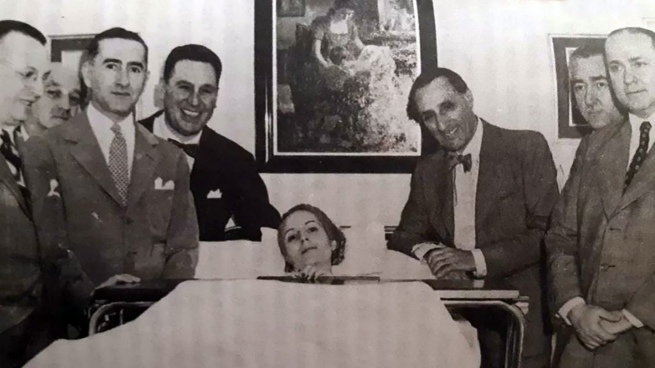The personalities that earn a place in history are those that manage to endure with their legacies in the collective memory, and can often become a dangerous symbol for a power that seeks to build an exclusive reality for the majority.
The body of Eva Perón, hidden, sullied and outraged by the agents of the so-called “Liberating Revolution”is an example of the extent to which the need to make everything that can inspire the struggle of the most neglected disappear.
The embalmed corpse of the “standard bearer of the humble” -by the work of the Spanish doctor Pedro Ara Sarriá- rested on the second floor of the CGT headquarters, on Azopardo street. He was waiting to be taken to a mausoleum that he planned to build in the second government of Juan Domingo Perón.
But the coup d’état of September 16, 1955 and the fall of Justicialism truncated that initiative in the context of a dictatorship that sought to banish all vestiges of Peronism.
What to do with Evita’s body became at that time the subject of strong discussions in the government, which was first led by Eduardo Lonardi and then continued by Pedro Eugenio Aramburu..
Throwing that body into the sea or burning it were the anticipatory intentions exhibited by the military who wanted to prevent the CGT headquarters from becoming a place of pilgrimage for the Peronist masses.
In November 1955 an internal coup took place that displaced Lonardi from the presidency -who had spoken of governing without “winners or losers” after the overthrow of Perón-, and Aramburu, who embodied the most radicalized sectors of the regime, took over the power.
The head of the Army Information Service (SIE), Lieutenant Colonel Carlos Moori Koenig, and his deputy, Major Eduardo Arandía, removed Evita’s body from the CGT during those days.
The order was to give that body a clandestine burial. But Moori Koenig, a staunch anti-Peronist, became obsessed with possessing the corpse and began to drive it around different parts of Buenos Aires in a flower van for fear that it would be stolen by sympathizers of the person who was called by the dictatorship and his adherents the “fugitive tyrant”.
The course of that body was a hermetic secret. However, the Peronist resistance seemed to have good information.
Flowers and lighted candles appeared as a tribute to Evita and her kidnapped body as the van passed.

The obsession of the head of SIE for the corpse that knew how to be outraged by his captors increased with the days. Arandía decided that the best thing to do was to deposit her in the attic of his house.
The eldest spent the nights awake, fearful that a resistance group would raid his house. and take the body he was guarding with a zeal as sick as the one his boss had developed.
One morning the soldier was crouched in a corner of his house; he heard noises, saw a figure advancing and shot at the bundle, emptying the magazine of his service weapon. That was how he killed his pregnant woman who was coming home late from visiting a sick relative.
After the painful incident carried out by his subordinate, Moori Koenig then wanted to take the body home, but his family absolutely prevented him..
He then took the body to his office, where he deposited it in a box placed upright. Evita was exhibited to the confidants of the lieutenant colonel, who also harassed and groped her.
Acquaintances of the head of the SIE denounced the “non-Christian” practices that Moori Koenig had with that outraged body before the head of the Military House, Navy Captain Francisco Manrique.
Aramburu ordered the transfer of the lieutenant colonel to a remote unit in Patagonia and ordered an operation to take the body to Milan, Italy, where Evita was buried in the main cemetery of that city, under the custody of the order of Saint Paul.
The burial was part of an “Operative Transfer”, headed by Colonel Héctor Cabanillas, Moori Koenig’s successor in the SIE, was in charge of this plan that had the consent of the authorities of the order and the highest ecclesiastical hierarchies.
Evita was buried under the name of María Maggi de Magistris, and for 14 years, a consecrated laywoman of the order of Saint Paul nicknamed “Tía Pina” brought flowers to her tomb without knowing that the body of the inspirer of the shirtless.
In May 1970 and during his kidnapping, Aramburu confided in the members of the Montoneros group that Evita was in Italy and that she had been given a Christian burial, but she refused to give further details, according to her captors who ended up executing the former dictator. .
A year later and as part of the so-called Great National Agreement (GAN), the dictator Alejandro Agustín Lanusse ordered the delivery to Perón of the body of his second wife.
Cabanillas was in charge of exhuming the body in Milan and moving it to Puerta de Hierro, the house that Perón had during his exile in Spain.
Perón finally returned to Argentina in 1973, but Evita’s body remained in Spain for some time.
In October 1974, this time Montoneros kidnapped Aramburu’s body to demand that Evita’s remains be returned to the country.
A month later, Isabel Perón – who had held the presidency since the death of the PJ leader – accepted and arranged for the body to return to Argentina.
Evita’s remains were deposited together with those of Perón, in a mausoleum located in the Olivos Residence.
After the 1976 coup, the soldiers who began to carry out state terrorism and the systematic plan of human rights violations analyzed again what they should do with the body, and finally decided that it was best to give it to Eva’s sisters. .
Evita was deposited in the second basement of the Duarte family vaultfive meters underground, in the Recoleta cemetery, where she rests to this day in peace and safe from those who tried to condemn her to oblivion.
















